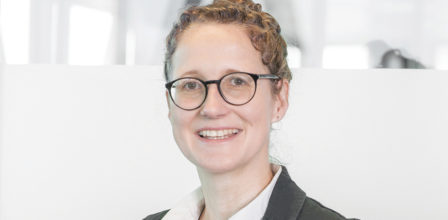Full transformation ahead! Introducing the new Quoniam Climate Equities strategy
The new Quoniam Climate Equities strategy actively captures the opportunities associated with climate change and sustainable transformation. The focus is on companies that are strongly committed to emission reductions. Claudia Röring, Dr Laura Jehl and Johannes Lins explain the benefits of a forward-looking approach.

How did the idea for Quoniam Climate Equities come about?
Claudia Röring: Our clients are increasingly concerned about the impact of climate change on their portfolios. They want to take advantage of the opportunities of sustainable transformation by investing in companies that offer potential returns due to technological innovation or successful adaptation of their business models to climate change. At the same time, a broadly diversified portfolio that systematically avoids unintended sector or factor risks is also important to them. We have developed the Climate Equities strategy specifically for these needs in typical Quoniam fashion: on the basis of extensive research.
The strategy invests globally in companies that are potentially well positioned for the impacts of climate change, for example, because higher profitability is expected in the future through clean production or growth through innovative technologies. Furthermore, we actively manage climate risks. This includes investing in companies with high current emissions if they have a convincing decarbonisation strategy.
How does Quoniam identify such transformation candidates?
Dr Laura Jehl: To identify these candidates, we have developed a climate transformation signal. The signal captures the opportunities of climate change by overweighting transformation candidates – i.e. companies that are well positioned to meet the challenges of climate change and are committed to reducing their emissions in the long term. To do this, the signal uses a variety of data. First, we look at companies’ climate targets, including the targeted annual reduction as well as the ambition level and degree of target achievement. In addition, we use data on the management of operational and product-related emissions risks, as well as on opportunities from new technologies and green patents or the shift to renewable energy sources.
“The signal captures the opportunities of climate change by overweighting transformation candidates – i.e. companies that are well positioned to reduce their emissions in the long term through new technologies and business models.“

Dr Laura Jehl,
Research Analyst
Moreover, we ensure that the strategy has a positive impact on the UN development goals on clean energy and climate protection.
Why does Quoniam focus on forward-looking data and transformation candidates?
Dr Laura Jehl: To answer this question, one must distinguish between the two basic approaches to sustainable investing.
One is the avoidance strategy found in (passive) climate indices such as the Paris-aligned benchmark: Such indices support the impact of companies with low emissions. In this way, companies that are not yet clean are penalised. Companies that are already sustainable or whose business model does not cause significant emissions, i.e. that hardly need any support in the transformation, are rewarded. The idea behind this is that “dirty” companies passively receive an incentive to change through exclusion.
Passive climate indices that function according to this principle focus on past-oriented measures and contribute minimally to the future reduction of CO2 emissions. In addition, they bring with them the risk of portfolio bias, as they are usually concentrated in sectors such as IT or finance.
Another approach, which makes more sense in our view, is to support future climate impact and invest in companies with high emissions – on the condition that the potential to reduce emissions is high. Here, active investment creates an incentive for change. A reduction in the future can bring potential returns and increase the valuation.
Our research has shown that companies with high emissions often have better scores on forward-looking metrics such as a Carbon Emission Management Score or the number of patents on climate-related technologies. We also see a correlation between companies’ climate targets and future reductions. In addition, it is important to assess the quality and level of ambition of climate targets.
How does portfolio construction work in practice?
Johannes Lins: The climate portfolio is created by optimising the climate transformation signal explained by Laura, combined with fundamental valuation and quality characteristics as well as trend aspects. In this way, both transformation potential and fundamental data are taken into account. For example, the value of the green patent portfolio in relation to total assets is a pure quality measure that should be considered in combination with the valuation of a company’s assets.
We rely less on extensive exclusions in the construction, but rather focus on the systematic mapping of the transformation signal. Compared to many other ESG strategies, this allows us to generate a more broadly diversified portfolio with a simultaneous active focus on emissions reduction and innovation. This results in a clear focus on climate-relevant sectors.
“Compared to many other ESG strategies, we can generate a more broadly diversified portfolio while actively focusing on emissions reduction and innovation.”

Johannes Lins, CFA
Portfolio Manager Equities
To be able to monitor the strategy with regard to its climate risk profile, we have an independent climate risk model at our disposal in addition to the proprietary signals described above. This allows us to evaluate the risk-return ratio of the portfolio under various climate scenarios.
What are the strengths of Quoniam’s Climate Equities strategy? What distinguishes it from other climate strategies?
Claudia Röring: What makes the strategy stand out is the combination of the strengths of a quantitative investment approach, i.e. a sound scientific basis as well as a broadly diversified investment universe, with the Quoniam Climate Signal, which systematically identifies the companies with the best responses to climate change.
Other active sustainability strategies are often more concentrated and can have a higher unsystematic risk, while broadly diversified, passive sustainability strategies, as explained before, can hardly take advantage of the opportunities of future emission reductions.
“Quoniam Climate Equities actively exploits the opportunities of sustainable transformation and, at the same time, benefits from our proven systematic investment process with stringent risk management.”

Claudia Röring,
Head of Product Management
Our strategy addresses multiple dimensions: It actively exploits the opportunities of sustainable transformation with a portfolio that aims for a target path of less than 2°C warming. At the same time, Quoniam Climate Equities benefits from our proven systematic investment process with stringent risk management.



